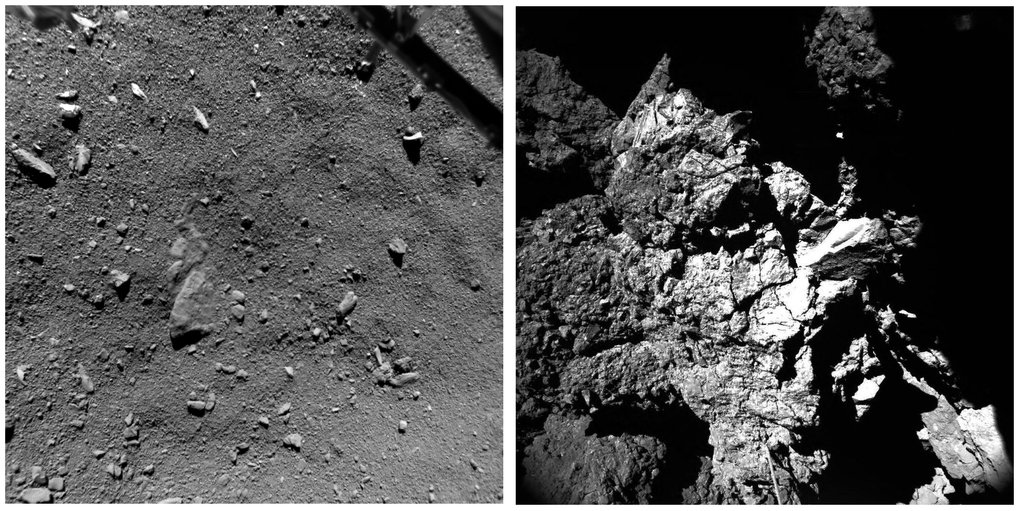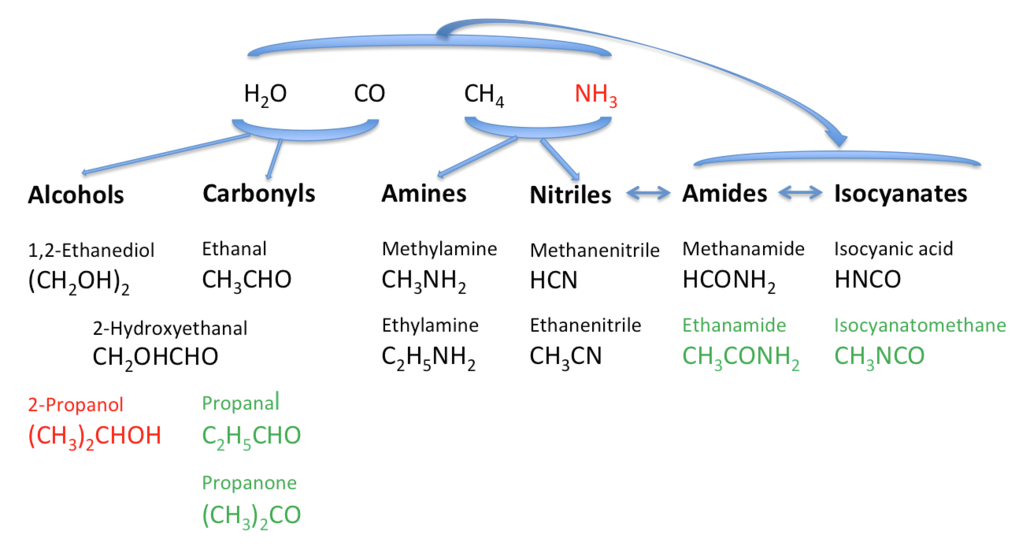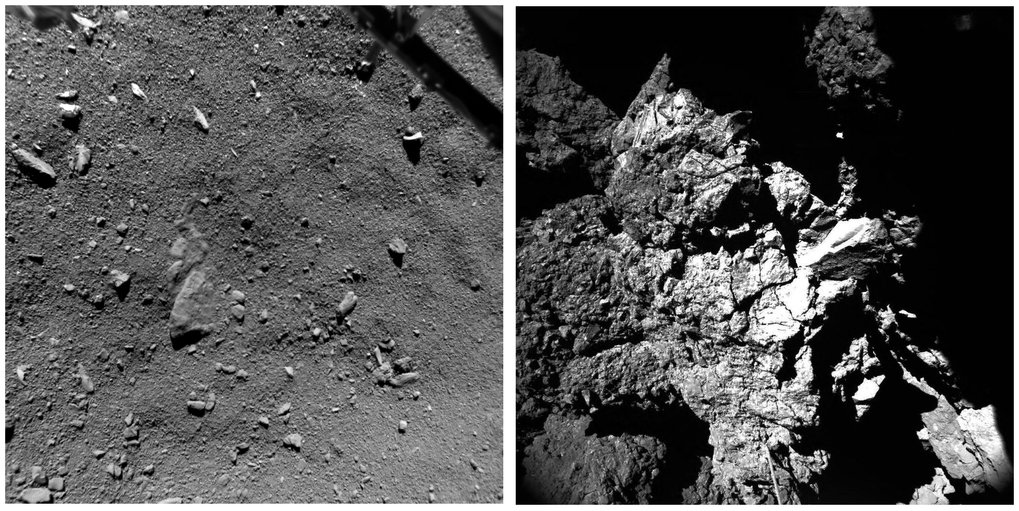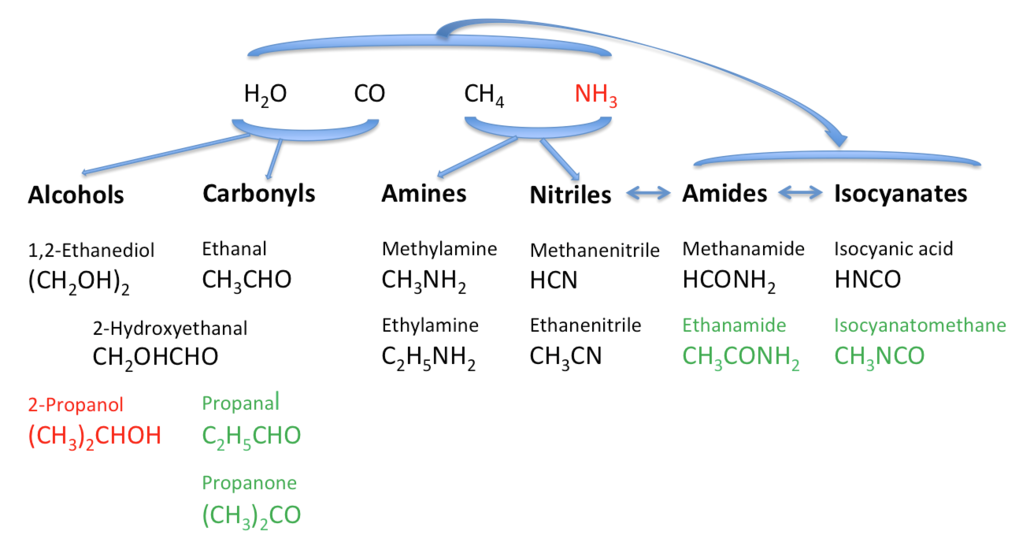Rosetta’s Comet: News from the surface
The measurements made by the Philae lander on Churyumov-Gerasimenko provide initial results
The surface dust of Rosetta’s comet 67P/Churyumov-Gerasimenko contains a wide variety of organic molecules. Researchers led by the Max Planck Institute for Solar System Research in Göttingen have been able to detect a total of 16 compounds in measurement data from the COSAC instrument which were recorded shortly after the Philae lander first touched down on the surface of the comet on 12 November 2014. Many of the substances are considered to be key molecules for biochemical reactions – in the creation of sugars or amino acids, for example. Thecurrent edition of the journal Science is dedicating a total of eight articles to these and further results of Rosetta’s landing mission. In a further publication, researchers working with the Max Planck Institute for Solar System Research reconstruct what precisely happened during the landing. The calculations allow conclusions to be drawn about characteristics of the comet’s surface. While Philae first touched down in a soft, dusty region, its final landing place is much firmer.

At 4.34 pm on 12 November 2014 Philae, the lander teamed up with ESA’s Rosetta space probe, touched down on the comet 67P/Churyumov-Gerasimenko at the Agilkia landing site, rebounded and executed a total of three hops before finally coming to rest at the Abydos landing site some two hours later. Philae spent around 60 hours carrying out scientific measurements on the surface of the comet before the lander ran out of the necessary power. Several of the instruments had already swung into action as the lander was hopping about, the COSAC instrument being one of them.
Philae kicked up around 0.4 cubic metres of dust the first time it touched down on the comet’s surface in the Agilkia landing site. A stroke of luck, because the dust was thus able to enter the inlet of the COSAC instrument on the underside of the lander, which was actually supposed to “sniff out” the gases close to the comet’s surface during the landing. “The dust it threw up is the most primordial cometary material that the Rosetta mission and all cometary missions before it have so far been able to get hold of,” explains Fred Goesmann, head of the COSAC team at the Max Planck Institute for Solar System Research. Although numerous Rosetta instruments are investigating the dust, which meanwhile forms a dense layer over the comet, this dust could change as it makes its way from the surface into space – especially in chemical terms.
A construction kit full of biochemistry

Overview of the 16 compounds detected by the COSAC instrument in the dust from the surface of the comet: They are labelled in black and green. Green additionally denotes the four substances which these measurements discovered for the first time in a comet. The graphic also shows how these compounds could have formed from the simple molecules water, carbon monoxide, methane and ammonia. The molecules labelled in red (such as ammonia) were not detected in the current measurements.
The COSAC researchers have been able to detect a total of 16 organic compounds in the material from the surface. They include alcohols, amines and nitriles, which had already been discovered in the gas clouds of various comets – sometimes by means of terrestrial observations – and also the “newcomers” methyl isocyanate, acetone, propanol and acetamide. The majority of the molecules contain nitrogen.
“All in all it is a veritable construction kit of organic compounds, many of which can serve as a precursor for important biochemical reactions,” says Goesmann. Key molecules for the synthesis of sugars, amino acids, peptides and nucleotides were found, for example. Many researchers believe that such complex molecules, which are thought to be the building blocks of life, originally reached Earth by means of cometary impacts.
The measurement data are not able to say whether these building blocks of life are even to be found in cometary material as well. If they are, the concentrations of such heavy molecules would be too low for an unequivocal identification.
The molecules which are not found also tell a tale
Goesmann makes the point that “COSAC is built to analyze gaseous substances. This means we were able to register only those compounds which vaporized from the dust particles at temperatures of between 12 and 15 degrees Celsius, the temperature inside COSAC at the time the measurement was made.” The concentrations of the more complex molecules were possibly too low to be detected at such mild temperatures.
The molecules which are not present - carbon dioxide and ammonia, for example - say at least as much as those that are discovered. Carbon dioxide is deemed to be one of the main constituents of cometary ice; ammonia must once have been present as the precursor for the numerous nitrogen compounds. “We had actually definitely expected to find these two molecules,” says Goesmann. “The fact they have not been found indicates that Philae descended in a region from which such easily volatile substances have long since vaporized,” adds the researcher.
The COSAC researchers now hope that the communication between Rosetta and the lander, which woke up again in the middle of June, will stabilize and that COSAC can once again go into action. Philae’s final landing site is probably located more than one kilometre from the place where it first touched down. What’s more, the temperatures have meanwhile risen considerably. “It is thus quite conceivable that a further measurement brings to light as yet undiscovered molecules,” says Goesmann.
The landing divulges a lot about the surface of the comet
Exactly how did Philae touch down on the surface of the first landing site, Agilkia? How did the mini space ship rebound and fly on? And what did the final landing in the region known as Abydos look like? The answers to these questions are provided not only by the scientific instruments aboard Philae, which were already switched on as the lander descended, but also by internal data from the lander itself. A team of researchers under the leadership of the German Aerospace Center (DLR) has reconstructed the landing in detail from all these pieces of the jigsaw.
“Our aim is not only to evaluate the landing as such,” explains Reinhard Roll from the Max Planck Institute for Solar System Research, who played a significant part in the analysis. “What exactly happened in the course of the landing teaches us a great deal about the mechanical characteristics of the comet’s surface.”
The first landing site, for example, had a considerable damping effect on Philae’s impact: The lander then hopped on at only a third of its original speed of one metre per second. “Only a fraction of this damping is down to Philae’s internal damping system,” says Roll. “The surface of the comet also played its part.” Philae’s feet also left clear impressions in the dust.
Philae first touches down as if in freshly fallen snow
All in all, the data suggest that the first landing site, Agilkia, is covered by a layer of dust around 20 centimetres thick. The pressure resistance of this layer is probably comparable to that of freshly fallen snow or the down filling in a feather pillow. There could be a firmer layer below.
Its final landing site, Abydos, presents a completely different picture. Neither Philae’s feet nor its ice screws penetrated into the ground there to any great depth; the hammer of the MUPUS instrument was unable to break through the surface. The current calculations indicate that the firmness of this surface is two thousand times greater than that of the first landing site.
“Our analyses agree with results obtained by other scientists,” says Roll. Analyses of images from the OSIRIS scientific camera system on board Rosetta had shown that the two landing sites belonged to very different morphological regions. “Rosetta’s comet is obviously an extremely multi-facetted place.”
More about Rosetta, Philae and COSAC
Rosetta is a mission being undertaken by the European Space Agency ESA with contributions from the member states and the US space agency NASA. Rosetta’s lander Philae was provided by a consortium led by the German Aerospace Center (DLR), the Max Planck Institute for Solar System Research (MPS) and the French and Italian Space Agencies (CNES and ASI). Rosetta is the first mission in history to fly to a comet, accompany it as it orbits the Sun and set a lander down onto its surface.
The Max Planck Institute for Solar System Research (Germany) led the development and construction of COSAC. The project partners are the Laboratoire Inter-universitaire des Systèmes Atmosphériques (France), the Laboratoire Atmosphères, Milieux, Observations Spatiales (France) and the University of Giessen (Germany). The German Aerospace Center (DLR) and the French Space Agency (CNES) provided financial support for the COSAC project.
HOR/BK

